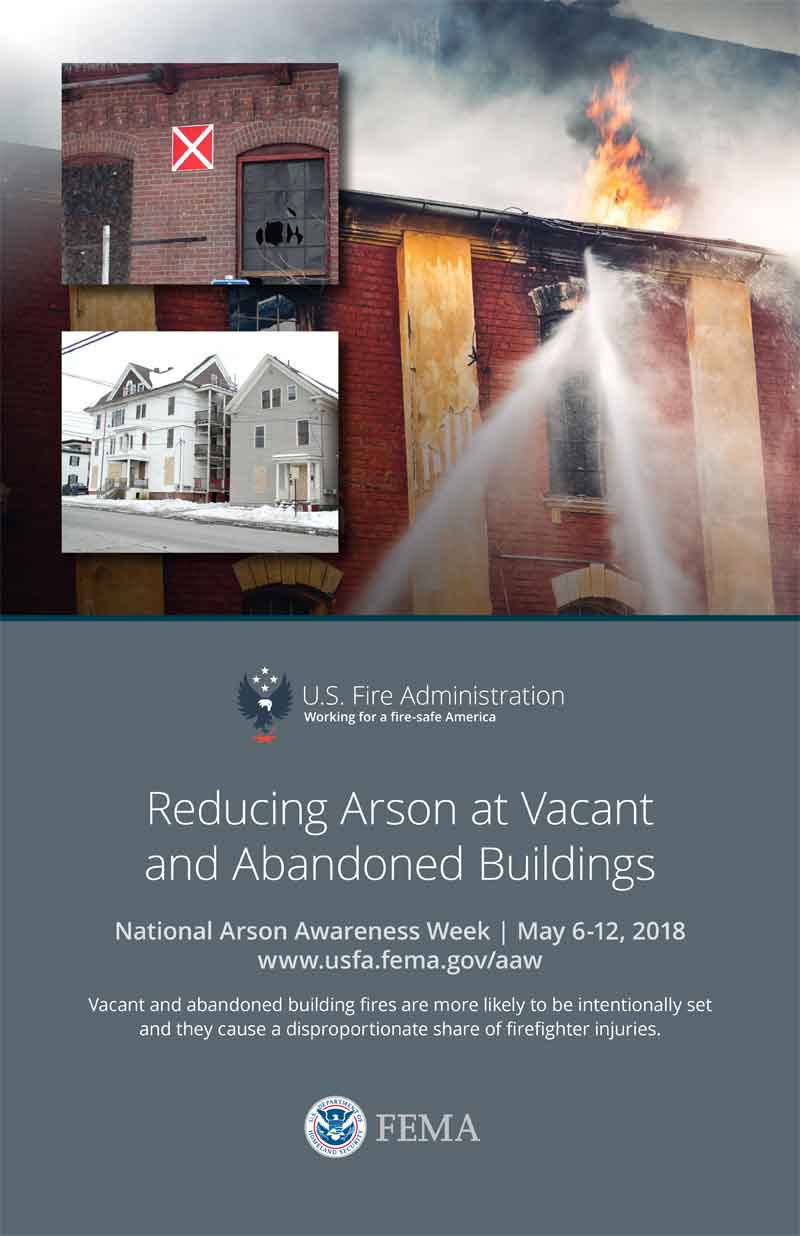
The theme for the 2018 Arson Awareness Week is Reducing Arson at Vacant and Abandoned Buildings.
Each year for Arson Awareness Week (AAW), the U.S. Fire Administration (USFA) gathers and shares information to raise awareness of arson or youth firesetting and provide to individuals with strategies to combat these problems in their community.
The United States Fire Administration (USFA) is pleased to announce first-time partner: the U.S. Department of Housing and Urban Development (HUD).
USFA will also partner with an important group of organizations comprised of the Bureau of Alcohol, Tobacco Firearms and Explosives (ATF), the International Association of Arson Investigators (IAAI), National Volunteer Fire Council (NVFC), National Fire Protection Association (NFPA), Coalition Against Insurance Fraud and the Insurance Committee for Arson Control (ICAC).
The week of May 6 to 12 will be used to focus on the importance of a cooperative effort with fire and emergency service departments, law enforcement and public works to help prevent the horrendous crime of arson at vacant and abandoned buildings.

They are sharing information and materials that will help fire departments keep firefighters safe when responding to incidents — and help community leaders address the issue of arson — in vacant and abandoned buildings.
This year’s materials for abandoned and vacant buildings will:
- Highlight basic evaluation procedures.
- Provide recommendations to help communities deal with issues surrounding these buildings.
- Spotlight training available to fire investigators.
- Explain the advantages of clear boarding, an alternative to plywood for boarding up empty properties.
According to the U.S. Fire Administration’s National Fire Incident Reporting System, at 34 percent, intentional actions were the leading cause of vacant residential building fires.
The ATF’s Bomb Arson Tracking System, reported there have been an average of 550 incendiary/arson fires per year at abandoned and vacant properties for the 10-year period from 2007 to 2016.

“Unsecured vacant or abandoned structures create an inherent risk to the courageous firefighters that respond to these fires,” said USFA Administrator Keith Bryant.
HUD Community Development Block Grants have provided grants to communities that suffered from foreclosures and abandonment.
HUD purchased and redevelop foreclosed and abandoned homes and residential properties assisting in the rejuvenation and revitalization of communities nationwide.
Each year, an estimated 23,800 vacant residential building fires are reported to U.S. fire departments and caused 75 deaths, 200 injuries and $785 million in property loss.
A major concern when a vacant building catches on fire is that little is known about the building’s overall condition.
Many buildings are in disrepair and can be missing certain structures, such as staircases or portions of floors.
If people use the vacant building as a home or shelter, the unknown condition of the building and the unknown number of people in the building can put firefighters’ lives in danger when they enter to attempt a rescue during a fire.
Learn more about vacant home fires from a free report, “Vacant Residential Building Fires (2013-2015)” in the USFA Topical Fire Report Series at https://www.usfa.fema.gov/downloads/pdf/statistics/v18i9.pdf.
(See in Action. Courtesy of Upper Images and YouTube. Posted on Jul 18, 2017)
Important Findings in the Vacant Residential Building Fires (2013-2015)Include:
- Each year, from 2013 to 2015, an estimated 23,800 vacant residential building fires were reported to fire departments within the United States and caused an estimated 75 deaths, 200 injuries and $785 million in property loss.
- Vacant residential building fires are considered part of the residential fire problem and accounted for 6 percent of all residential building fires.
- Nonconfined fires accounted for 99 percent of vacant residential building fires.
- At 34 percent, intentional actions were the leading cause of vacant residential building fires.
- Of vacant residential building fires, 53 percent spread to involve the entire building. An additional 10 percent extended beyond the building to adjacent properties.
- At 12 percent, bedrooms were the leading area of fire origin in vacant residential building fires. Following closely were common rooms, such as dens, family rooms and living rooms (11 percent), and cooking areas/kitchens (8 percent).

















